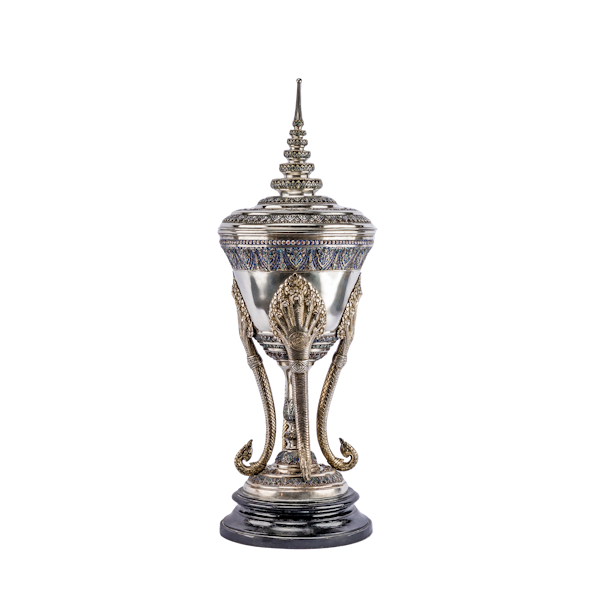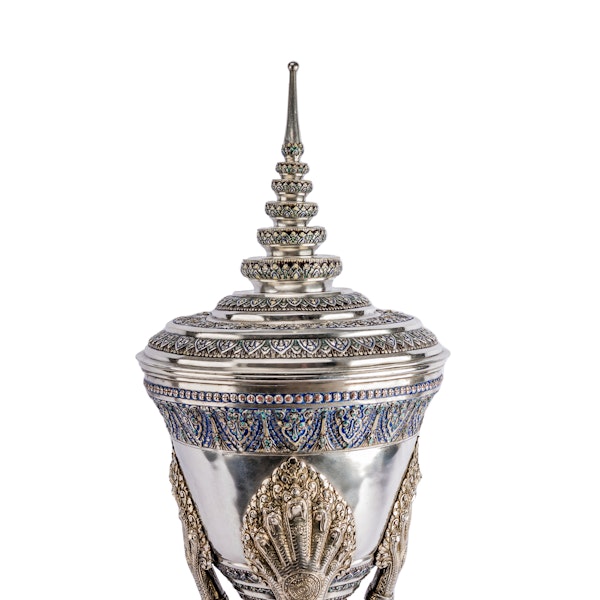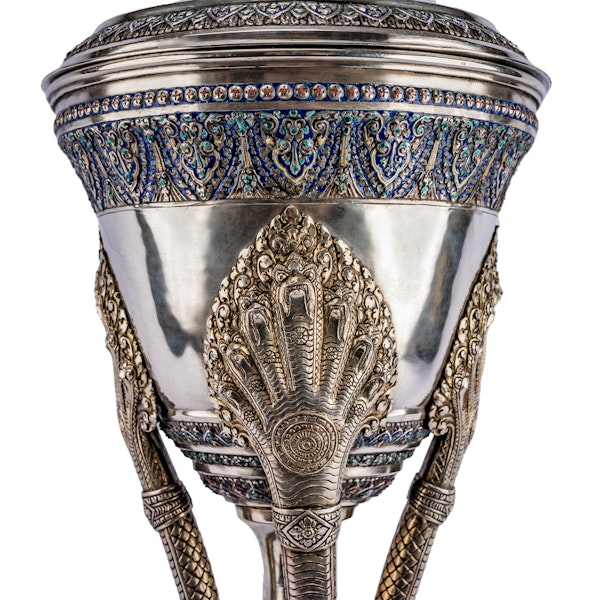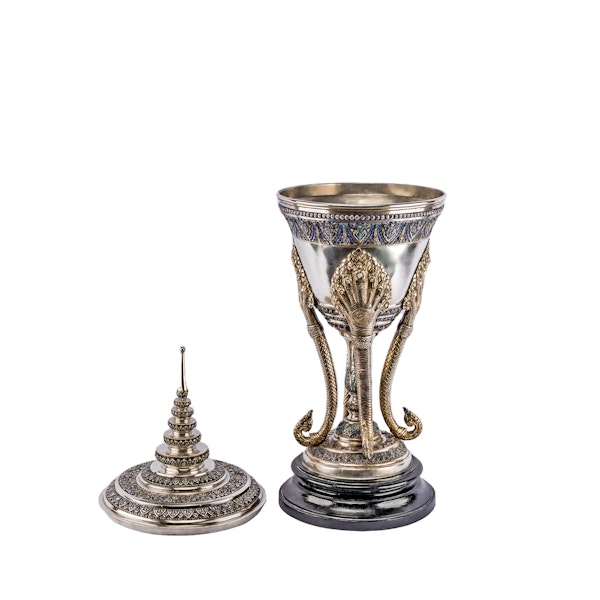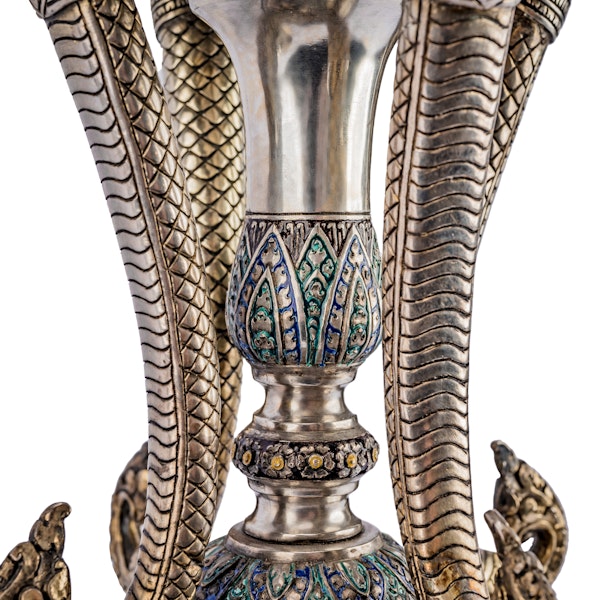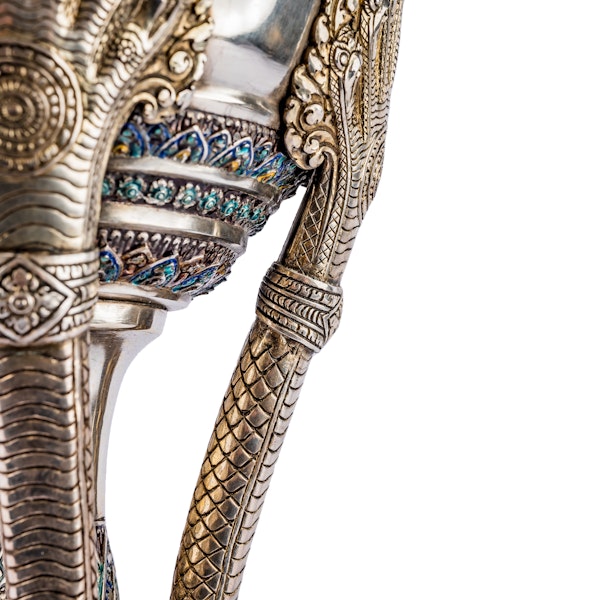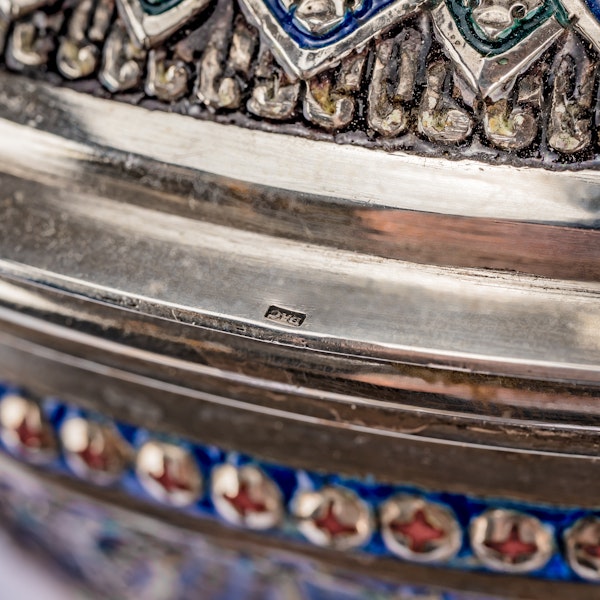An exceptional late 19th century Cambodian silver and enamel funerary urn of traditional form
An exceptional late 19th century Cambodian silver and enamel funerary urn of traditional form
POA
Description
An exceptional late 19th century Cambodian silver and enamel funerary urn of traditional form, the lid being formed of a series of multi-tiered conical forms terminating in a spire resting on a tapered highly decorated bowl which is supported with a central column and four pillars formed of Naga, the whole resting on a wooden base.
Cambodian funerary traditions are based upon the tenants of the Theravada Buddhist tradition. Buddhism has been present in Cambodia since at least the 5th century, in its earliest form it was a type of Mahāyāna Buddhism. The earliest forms of Buddhism, along with Hindu influences, entered the Kingdom of Funan with Hindu merchants. In later history, a second stream of Buddhism entered Khmer culture during the Angkor Empire when Cambodia absorbed the various Buddhist traditions of the Mon kingdoms of Dvaravati and Haripunchai. From the 11th century the Theravada tradition became increasing present and as the Angkor Empire declined its influence increased promoted by monks from Sri Lanka and increased trade and communication between the two nations. Traditionally when someone dies, their body is typically washed and then wrapped in a white shroud. The body is then placed on a funeral pyre and cremated. The ashes are then collected and placed in an urn.
The urns were made from a variety of materials, wood, ceramic, bronze, silver and in very rare cases gold. This example is clearly a high-status object and must have been commissioned for someone of wealth and influence. The design of the urns varies from very simple jars to more complex forms as exhibited by this example. There is often a strong influence from the architectural traditions that were developed during the Angkor Empire, and which continue to be employed today.
An 18th century mural depicting a Cambodian Royal funerary urn
The urn is in the traditional form of a chedi, the steeple-shaped mausoleums that are to be found in the grounds of a pagoda. The lid has several tiers around a central spire a design which is also derived from the architecture of the chedi and which is also to be found in the regalia of the kingdoms of Cambodia, Indonesia and Thailand most especially in the crowns or mokot.
The highly decorated surfaces of this urn display many motifs that originated in the architectural masterpieces of the Khmer Empire where intricate naturalistic forms were employed to great effect. These are further embellished with enamel of blue, green and red. The blue and green emphasise the luxuriant nature of the foliate decoration while the red enamel is employed in such a way as to suggest inset corals. In certain Buddhist sects there is a belief that trees of coral grow in paradise and red is the colour of the Buddha and therefore a suitable embellishment to the urn.
The magnificent Naga that coil from the base with their seven heads supporting the urn derive from the sculptural decoration at Angkor. These mythical semi-divine creatures have a long tradition in Hinduism, Buddhism and Jainism and a strong traditional history in Cambodia including a legend that the royal dynasty of Funan were descended from a marriage between a human prince (Kaundinya) and a Naga princess (Soma). The Khmer people believe they are in fact descendants of the Nagas, and many believe they exist and will return to bring prosperity.
Naga in the Khmer culture represent rain, or a bridge between the mortal realm and the realm of devas (Heaven), and they can transform into half human or fully human. They act as protectors from invisible forces, deities, or other humans with malicious intention. Furthermore, Cambodian Naga possess numerological symbolism in the middle of their heads. Odd-headed Naga symbolize masculinity, infinity, timelessness, and immortality. This is because, numerologically, all odd numbers come from the number one. Seven-headed Naga are said to be representing femininity, physicality, mortality, temporality, and the Earth. Odd headed Nagas are believed to represent immortality and are carved and used throughout Cambodia.
At the entrance to the great temple of Angkor Wat there is a statue of the mythical Naga, the seven-headed protector of Buddha, and a statue of the guardian lion.
As well as these specifically Cambodian traditions, Buddhism relates the legend of Mucalinda, the King of the Naga who spread his heads over the Gautama Buddha to protect him from the elements as he meditated under the Bodhi Tree having obtained enlightenment.
The symbolism of the Naga, as protectors and embodying the bridge between the earthly and divine as well as the specifically Cambodian traditions make them an appropriate and dramatic feature of the urn.
| item details | |
|---|---|
| Origin | Oriental Other |
| Period | Early 1900s |
| Style | Other |
| Condition | Excellent |
| Dimensions | W: 22.5cm H: 53.5cm |
Product REF: 10006
